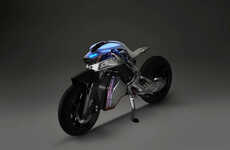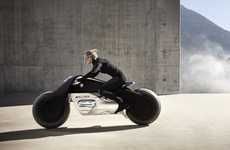
The 'GyroCycle' is a Two-Wheeled Motorcycle that Balances Itself
Michael Hemsworth — December 2, 2016 — Autos
References: thrustcycle & yankodesign
Designed by Clyde Igarashi for Thrustcycle, the 'GyroCycle' is a two-wheeled motorcycle that aims to make it easier for virtually anyone to ride a motorcycle who might feel they aren't ready for the challenge.
The 'GyroCycle' is capable of self-balancing, which means it can be ridden by experience bike riders or those who might not have ever learned. Moreover, it could be suitable for those who might have a bit of nervousness surrounding the balancing effort in general when it comes to riding a motorcycle.
The 'GyroCycle' features an internal gyroscopic balancing system that makes it nearly impossible for the two-wheeled motorcycle to fall over. This could help to eliminate the occurrence of avoidable crashes and help calm riders who might be nervous of something of this nature happening.
The 'GyroCycle' is capable of self-balancing, which means it can be ridden by experience bike riders or those who might not have ever learned. Moreover, it could be suitable for those who might have a bit of nervousness surrounding the balancing effort in general when it comes to riding a motorcycle.
The 'GyroCycle' features an internal gyroscopic balancing system that makes it nearly impossible for the two-wheeled motorcycle to fall over. This could help to eliminate the occurrence of avoidable crashes and help calm riders who might be nervous of something of this nature happening.
Trend Themes
1. Self-balancing Vehicles - With the 'GyroCycle', there is an opportunity for companies to innovate and develop new self-balancing vehicles, such as cars, scooters, or even bicycles, to enhance mobility and safety.
2. Assistive Technologies - The 'GyroCycle' highlights the potential for assistive technologies, such as self-balancing wheelchairs or mobility aids, to improve accessibility for people with mobility challenges.
3. Smart Transportation - Self-balancing motorcycles like the 'GyroCycle' fit into the trend of smart transportation, which involves developing more efficient and sustainable vehicles that enhance urban mobility as cities become more congested.
Industry Implications
1. Automotive - The automotive industry could incorporate self-balancing technology into cars, creating a new market segment of safe and user-friendly vehicles, especially for older or disabled drivers.
2. Medical Equipment - Self-balancing wheelchairs or mobility aids could be developed and marketed by companies in the medical equipment industry, offering increased mobility and independence to people with disabilities.
3. Recreational Vehicles - Recreational vehicle manufacturers could explore the potential of self-balancing technology in creating safer and more enjoyable experiences for thrill-seekers with products such as self-balancing ATVs or dirt bikes.
6.8
Score
Popularity
Activity
Freshness























